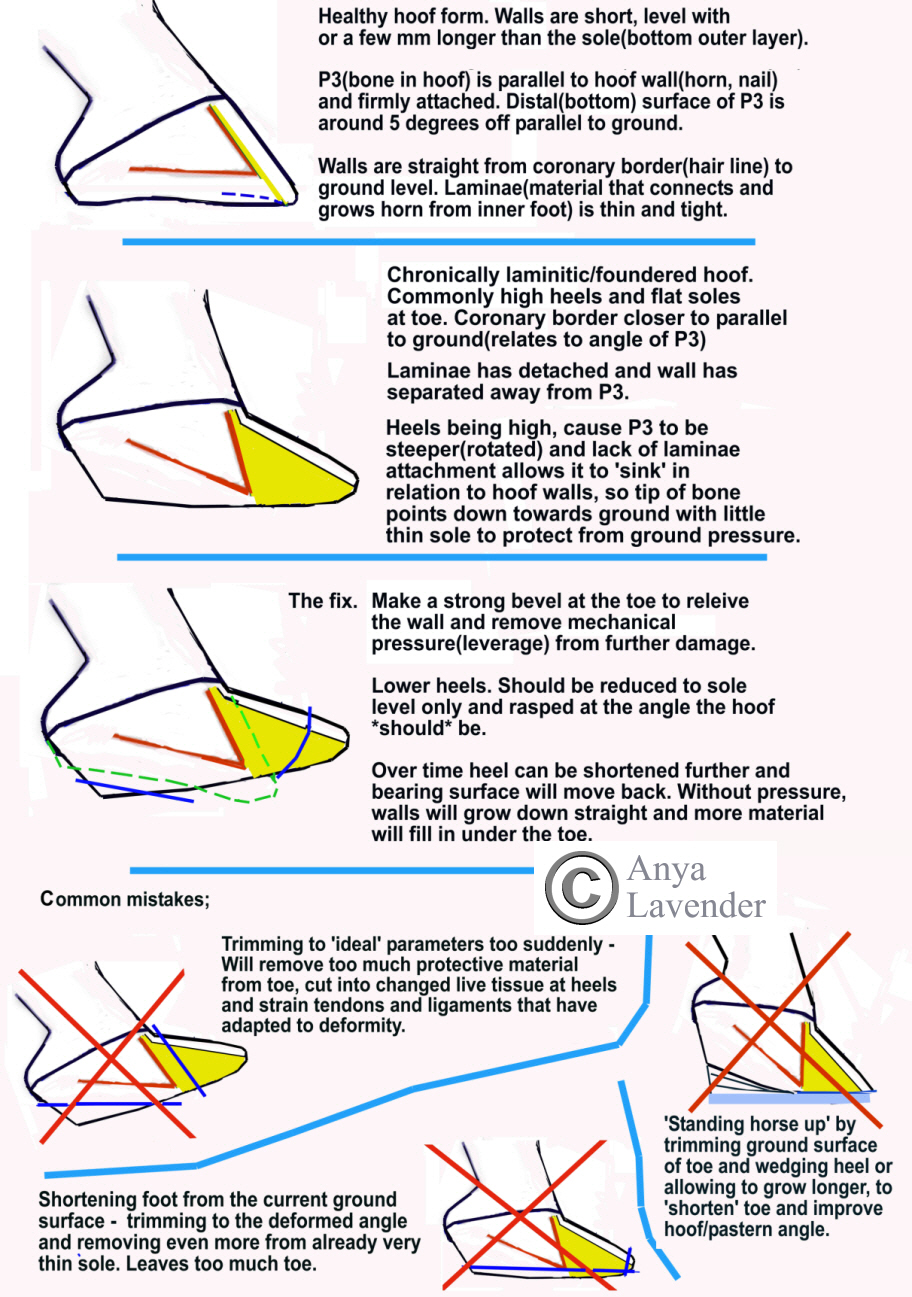
~By Anya Lavender. Copyright

'Laminitis' literally means inflammation of the lamellar tissue of the foot. It can be minor and short lived inflammation, termed mild or sub-clinical laminitis. In which case the horse may not be obviously uncomfortable and may not be accompanied by any obvious symptoms, or may cause only mild discomfort, particularly on hard ground or post trimming and leaves only minor 'growth rings' - horizontal rings or ridges around the circumference of the hoof, or pink horizontal rings evident in white feet. At the ground surface the laminae may be stretched, particularly at the toe and there may be pink from old blood in the 'white line'. While these signs aren't necessarily problematic yet, taken as 'warning lights', with good management, I believe we should be able to avoid the vast majority of clinical laminitis.
It can be 'acute' meaning there is major inflammation and the horse is in pain, obviously lame and may adopt the 'classic founder stance' or want to lie down. This can be brought on from systemic 'assult' such as grain/starch overload, rich grass, medication or toxins, mechanical causes such as 'road founder'. Acute laminitis usually means significant damage to the laminae and therefore hoof capsule at that point, but if short lived and treated properly, doesn't necessarily mean any ongoing or major problems.
It can be 'chronic', meaning it has gone on for a long time. Mechanical changes to the hoof are apparent, especially if not carefully managed with good hoofcare. As the laminae are damaged, the pedal bone(P3) can 'sink' &/or 'rotate' in relation to the wall. The sole is thin, particularly around the toe, and the foot has 'stretched' forward, often with a very flared toe. Heels often grow high, causing further 'rotation' and further removing the ability of the hoof to function well.
It can be a combination of the above states, with a wide range of degrees. For instance, a horse may be 'sub clinical' for some time and a trigger causes an 'acute' attack. A horse can be 'chronic' for a long time and go unrecognised until an 'acute' attack suddenly makes the problem obvious.
For anyone who has a laminitic or foundered horse, or one at risk, I HIGHLY recommend this fantastic & very comprehensive book The Pony That Did Not Die By Andrew & Nicky Bowe.
The red triangular line shows the pedal bone, which is surrounded by corium. This is why the inflammation can cause such pain and damage, sandwiched between bone and horn! The yellow shows the laminae, or lamellar wedge, when in chronic cases the laminae put out more material to fill the gap. The blue dotted line shows how the sole arches away from the wall. In chronic cases the sole may be flat or even bulging, especially at the toe. The solid blue lines indicate how you would(or wouldn't, as the last examples show) trim to correct the problem. The dotted green line shows how the foot 'should' be and needs to grow. We're not forcing this 'ideal' on the foot however, but *encouraging* or 'facilitating' it's development towards it.

Causes & Triggers
Diet is by far the most common cause of laminitis.Too much food generally which causes overweight or obesity, especially in the long term, without regular 'hard seasons' to use up the fat stores can lead to Insulin Resistance or Equine Metabolic Syndrome which is similar to Type 2 Diabetes.
Sugar/starch overload, commonly from feeding grain or access to over rich pasture, especially when fed in large &/or infrequent meals can cause Hind Gut Acidosis which damages the gut and leads to laminitis.
Equine Cushings and Insulin Resistance siteSite with info about diet and lifestyle as it relates to hooves
******Work in progress ~ Check back for more soon!*******